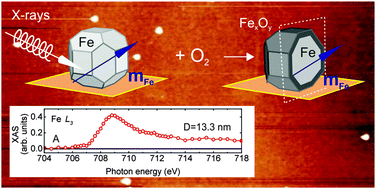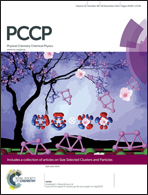In situ magnetic and electronic investigation of the early stage oxidation of Fe nanoparticles using X-ray photo-emission electron microscopy†
Abstract
We present an in situ experimental investigation of the magnetic and electronic properties of individual iron nanoparticles with sizes ranging from 8 to 22 nm as a function of oxygen exposure (0–80 L), using X-ray photoemission electron microscopy. The X-ray absorption spectroscopy results show that, irrespective of size and magnetic state, the early stages of the Fe nanoparticle oxidation occur through the initial formation of a non-magnetic FeO-like layer, followed by a progressive transformation of the latter to Fe3O4. At 80 L, the metallic iron core and the outer Fe3O4 shell are separated by a thin FeO layer. Our data suggest that the outer Fe3O4 layer has either a magnetic order that significantly differs from the respective bulk or that the FeO-like layer is responsible for a magnetic decoupling between the Fe3O4 shell and the iron core. Moreover, we find that the recently observed blocked magnetic state in the pure metallic iron nanoparticles persists upon oxygen exposure, demonstrating that the enhanced magnetic energy barriers do not originate from the free surface of the nanoparticles.

- This article is part of the themed collection: Size Selected Clusters and Particles: From Physical Chemistry to Catalysis


 Please wait while we load your content...
Please wait while we load your content...